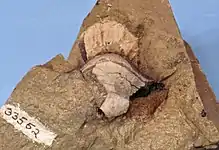| Petalodontiformes Temporal range: | |
|---|---|
 | |
| Belantsea montana | |
| Scientific classification | |
| Domain: | Eukaryota |
| Kingdom: | Animalia |
| Phylum: | Chordata |
| Class: | Chondrichthyes |
| Subclass: | Holocephali |
| Order: | †Petalodontiformes Zangerl, 1981 |
| Families | |
| |

Teeth of Petalodus ohioensis
Petalodontiformes ("thin-plate teeth") is an extinct order of marine cartilaginous fish related to modern day chimaera found in what is now the United States of America and Europe.[1]
Most species are known only from isolated teeth.[1][2] All fossils range from the Carboniferous to the Permian, where they are presumed to have died out during the Permian/Triassic extinction event.[1]
The two best known species are Belantsea montana, from the Carboniferous Bear Gulch, Montana, and Janassa bituminosa, from the upper Permian of Europe, as whole fossil specimens have been found of these two.
References
- 1 2 3 Lund, Richard, E. D. Grogan, and M. Fath. "On the relationships of the Petalodontiformes (Chondrichthyes)." Paleontological Journal 48.9 (2014): 1015-1029.
- ↑ Dalla Vecchia, Fabio Marco, and Museo Paleontologico Cittadino. "A new petalodont tooth (Chondrichthyes, Petalodontiformes) from the Lower Permian of the Carnic Alps (Friuli, NE Italy)." Bollettino della Società Paleontologica Italiana 39 (2000): 225-228.
This article is issued from Wikipedia. The text is licensed under Creative Commons - Attribution - Sharealike. Additional terms may apply for the media files.
